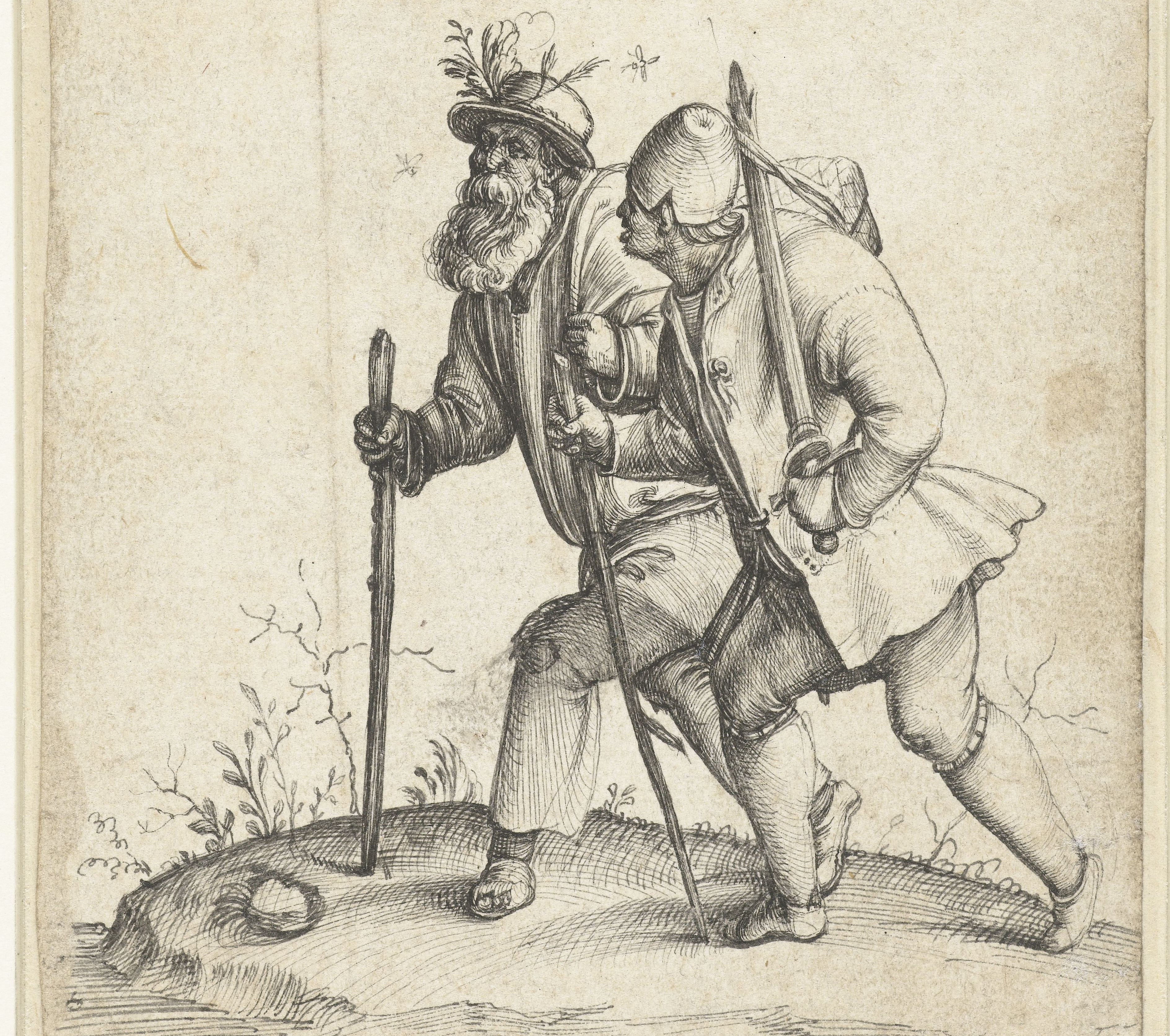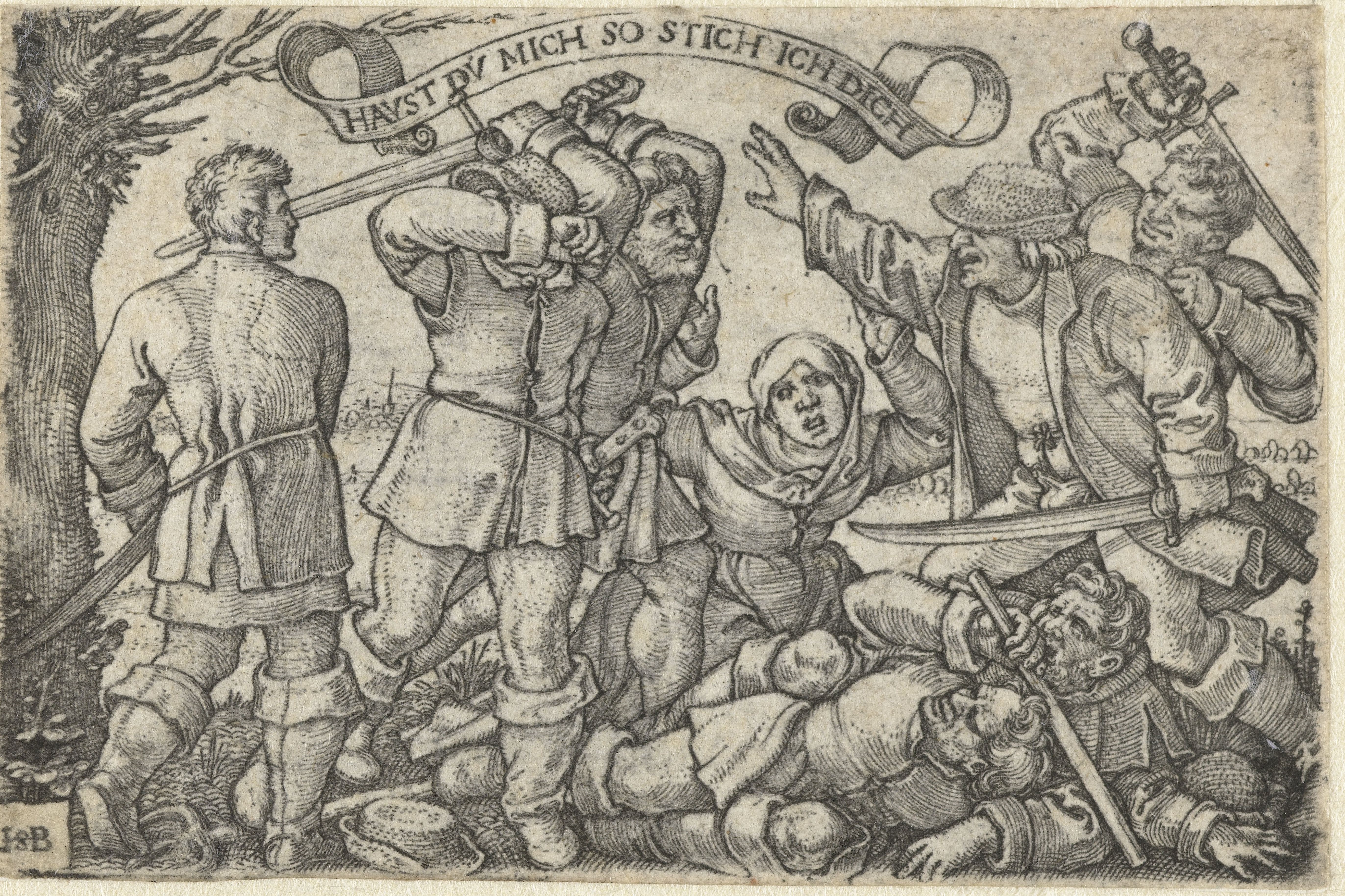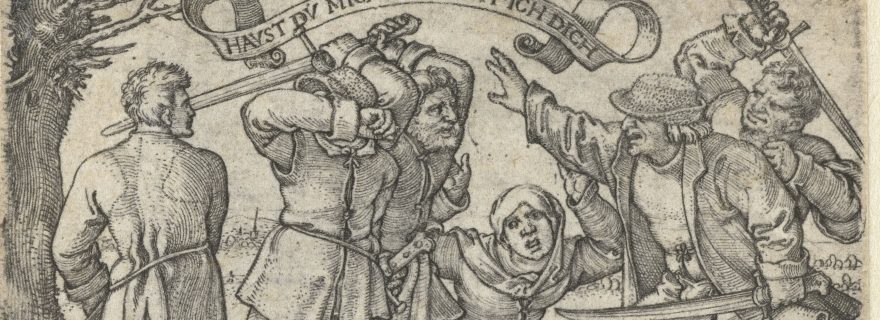A good guy with a sword. Weapons and communal culture in sixteenth-century Germany
Despite its different ideological foundations, modern North American gun culture had precedents in late medieval and early modern Europe, when weapons played an important role in communities that regarded an armed citizenry vital to public safety.
Armed communities
Among contemporaries, fifteenth- and sixteenth-century Germany was notorious for the widespread presence of weapons among its inhabitants, especially among those who lived in smaller towns and communities. In 1444, Enea Silvio Bartolomeo Piccolomini, the later Pope Pius II, who had served as an agent of the papacy and as a pastor in several German-speaking cities and duchies, noted that every respectable household was armed and that “the skill of the citizens in the use of weapons is extraordinary.” While medieval and early modern weapons possession is often associated with the nobility, townspeople and even villagers possessed swords, pikes, guns and pistols and kept them in their private homes.
The omnipresence of weapons in civic life did, however, not mean that the right to possess and use them was unregulated. While many smaller communities did not have written weapon laws, local and sometimes rather unfixed traditions regulated the use and possession of arms. Citizens could be fined for violations but the context in which members of local communities were rebuked was entirely different from modern gun and weapon regulations. As research in local town archives suggests, citizens were more likely to be fined for not being able to present a functioning weapon than for possessing an illegal one.
The typical context in which early modern German communities organized and channeled private weapons possession was in the institution of local town militias. These militias existed everywhere in Europe, and also played a significant role in Spain, the Netherlands and in England. Especially in areas with a decentralized and fragmented political structure, such as the Holy Roman Empire, ideals of civic and communal self-defense informed daily life and shaped a “culture of arms” that linked service in local militias to full membership to the community. While the ideal of an armed male citizenry was shared across wide parts of Europe, local realities differed: in most parts of the Italian peninsula, less than 7% of the male population served in militias, and burghers of Holland towns were notorious for buying themselves out of their armed duties, which included tiring night watches. In England, only 2% of the population was officially permitted to carry a fire arm. As B. Ann Tlusty argues in her fascinating study on the “martial ethic” in early modern Germany, the German numbers were often significantly higher and in many smaller towns, the large majority of male citizens served in armed militias. Even in cities that had issued more restrictive weapon laws in the course of the late Middle Ages, for example Nuremberg, the magistrates encouraged private arms possession and militia service in the sixteenth and seventeenth centuries.
The daily practice was, thus, based on the idea that crime, aggression and other threats to civic peace could best be stopped by armed members of the community. In some rural parts of Southern Germany, especially when they fell under the jurisdiction of neighboring Free or Imperial Cities, even peasant households were expected to maintain their own fire arms. Even in times of open rebellion, disarming people was seldom regarded as a measure that could reduce crime and unrest. When Württemberg peasants revolted against the territorial authorities in 1525 and 26, Ferdinand of Habsburg, the later Emperor, ordered that they turn in their guns and armor but it was explicitly stated that the peasantry could keep their swords and smaller side arms. Even in the face of uprisings, the benefits of an armed populace seemed to outweigh its potential danger.
Weapons and masculine identities
Carrying weapons was not only a privilege but also a duty, and the term waffenfähig (“weapons-capable”) did not only indicate that one was capable of bearing arms but also that male citizens were responsible to serve as defenders of their communities and households. The communal weapons culture of sixteenth-century Germany revolved around a civic cult of masculinity, in which arms served as signifiers of manliness. Weapons affirmed the social status of Christian household patriarchs and were not necessarily carried for defense purposes but also as emblems of social rank or even as mere fashion items. Shooting festivities and sword dances were popular events in German towns, and they allowed citizens and guild members to display their ability to handle their arms and prove their capability to serve as able members of their communities.
These patriarchal values were, however, not exclusive to married Christian men who wanted to prove their status as heads of a household. Groups who were not deemed waffenfähig participated in the culture of arms as well. Not being waffenfähig did not exclude people from the right to possess arms but rather indicated that militia service did not belong to their civic duties and, thus, students, Jewish men and even Catholic clergy often carried weapons as well. In Frankfurt, where some of the most prominent weapon dealers were Jewish, access to arms was particularly easy for their coreligionists and there is evidence that armed street fights occasionally took place within the Jewish neighborhood. However, the community denounced such excesses as unwanted influences of gentile culture and in the seventeenth century, a Frankfurt Rabbi berated two members of his synagogue of having assimilated “to the non-Jewish environment” after they had attacked each other with pikes.
Handling weapons belonged, thus, to a culture and an ethical system that was shared by most social groups. According to Tlusty, there is evidence that even women sometimes participated in urban shooting festivities. Students were one group that was particularly eager to defend its rights to carry swords, which can be interpreted as an attempt to imitate masculine behavior and to integrate into their later roles as respected citizens and community members. In many German towns, especially the smaller ones, remnants of the civic weapons culture remained undisputed far into the eighteenth century and in university towns they often merged with academic traditions. In late eighteenth century-novels of Johann Wolfgang von Goethe or Karl Philipp Moritz, students are proud to carry their rapiers on their belts during festivities or when they visit their parents.

Self-interest and the common good
While the 2nd Amendment of the United States Constitution explicitly refers to “a well-regulated militia”, modern gun culture largely revolves around a romanticized notion of individualism that celebrates the defense of private possessions. Early modern discourses on weapons were informed by arguments for both individual self-defense and the common interest. While many towns explicitly encouraged their citizens to purchase arms for the sake of communal safety, self-interest and the common good were regarded inseparable. A collective of self-defending citizens was considered the most reliable guarantee for communal safety and in the early eighteenth century, Augsburg and Rothenburg ob der Tauber started to promise amnesty from criminal charges to citizens who killed burglars in their private homes.
In 1564, Leonhard Fronsberger, Ulm burgher and author of several military treatises and handbooks, explicitly argued that self-interest was the foundation of the common good, even though it might not be regarded virtuous in itself. In his polemical treatise Von dem Lob deß Eigen Nutzen (“In Praise of Self-Interest”), he argues that the actions of individuals are hardly ever motivated by collective interest: even though no society can survive without the procreation of its populace, no one ever marries for the sake of the common good but only thanks to natural affection. Thus, the community’s well-being is based on the self-preservation of its members and the physical self-defense of each (male) individual was, thus, necessary to keep neighborhoods safe.
Obviously, half-trained citizens were no match for the ever-professionalizing armies that emerged in the sixteenth century. Yet, according to Fronsberger, local citizens were more suited to protect their communities than well-trained mercenaries – while the former defended their own households, neighborhoods and towns out of self-interest, the latter might turn against local inhabitants if the financial resources to pay them ran dry. Early modern soldiers were notorious for plundering and exploiting the towns they were paid to defend, and the notion that citizens who acted out of self-interest were more reliable, resulted in the continuity of the militia system even after the so-called “Military Revolution.” As in the United States today, threats to civic peace did, thus, not result in a decrease but, more likely, in a surge in private weapon possession. It should be noted that, unlike today, fire arms did not take the highest death toll and rapiers often proved even deadlier weapons, since guns or pistols tended to misfire or malfunction, especially when they were not used on a regular basis. It was impossible to commit a “modern” mass shooting with a pre-modern fire arm and we can only guess how sixteenth-century town authorities would have responded to devices as destructive as semi-automatic high-tech weapons. However, the idea that “a bad guy with a gun” might best be stopped by a “good guy with a gun” would not have rung strange to early modern German ears.

Further reading:
B. Ann Tlusty, The Martial Ethic in Early Modern Germany: Civic Duty and the Right of Arms, Basingstoke: Palgrave Macmillan, 2011.
Maarten Prak, Citizens, Soldiers and Civic Militias in Late Medieval and Early Modern Europe, Past & Present, Volume 228, Issue 1, 1 August 2015, p. 93–123.
© Johannes Müller and Leiden Medievalists Blog, 2018. Unauthorised use and/or duplication of this material without express and written permission from this site’s author and/or owner is strictly prohibited. Excerpts and links may be used, provided that full and clear credit is given to Johannes Müller and Leiden Medievalists Blog with appropriate and specific direction to the original content.


